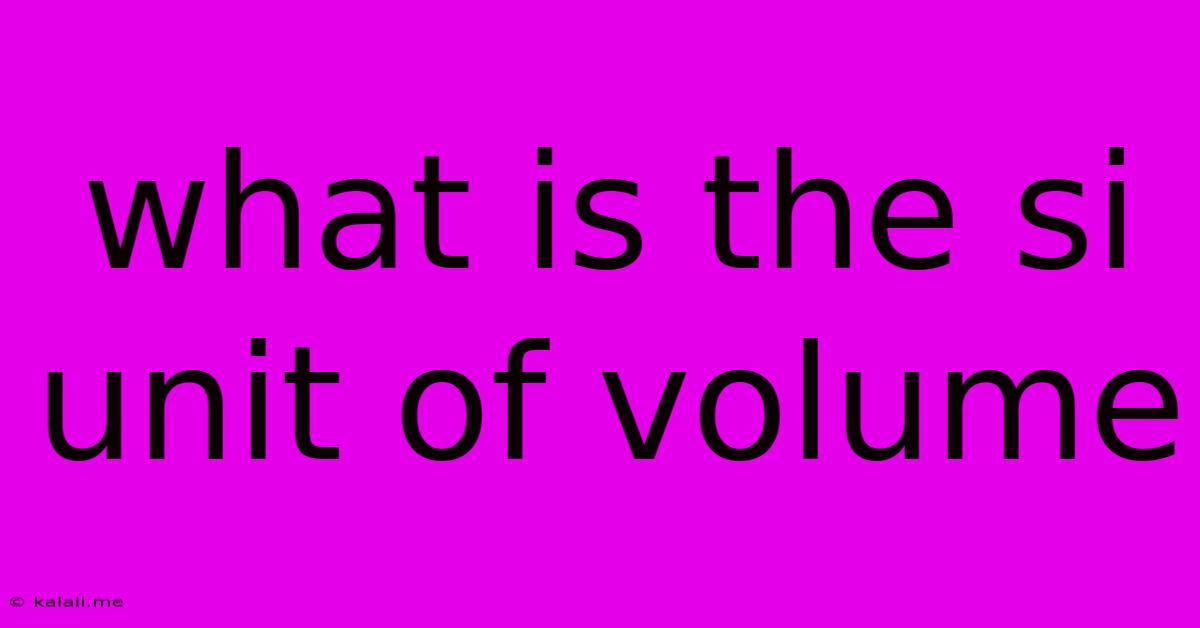What Is The Si Unit Of Volume
Kalali
May 10, 2025 · 3 min read

Table of Contents
What is the SI Unit of Volume? A Comprehensive Guide
The SI unit of volume is the cubic meter (m³). This means that the standard measurement for volume within the International System of Units is a cube with sides measuring one meter each. Understanding this fundamental unit is crucial for various scientific, engineering, and everyday applications. This article will delve deeper into the cubic meter, explore its relationship to other volume units, and provide examples of its practical use.
This comprehensive guide will cover the cubic meter, explore its relationship with other units, and provide examples of its use in different contexts. We'll also touch upon common conversion factors to make calculations easier.
Understanding the Cubic Meter (m³)
The cubic meter is a derived unit, meaning it's based on the fundamental SI unit of length, the meter. It represents the amount of three-dimensional space occupied by an object or substance. Imagine a perfect cube: if each side of that cube measures exactly one meter in length, then the volume enclosed within that cube is precisely one cubic meter.
Relationship to Other Volume Units
While the cubic meter is the standard, many other units are commonly used to measure volume, particularly for smaller or larger quantities. Understanding their relationship to the cubic meter is essential for accurate conversions. Some common examples include:
-
Liters (L): One liter is equal to one cubic decimeter (dm³), which is equivalent to 0.001 cubic meters (10⁻³ m³). Liters are frequently used for measuring liquid volumes.
-
Milliliters (mL): One milliliter is equal to one cubic centimeter (cm³), or 0.000001 cubic meters (10⁻⁶ m³). Milliliters are commonly used for smaller liquid volumes.
-
Cubic centimeters (cm³): Often referred to as "cc," a cubic centimeter is a thousandth of a liter and a millionth of a cubic meter.
-
Cubic kilometers (km³): Used for extremely large volumes, such as the volume of water in a large lake or the volume of a mountain.
Practical Applications of the Cubic Meter
The cubic meter finds application across diverse fields:
-
Construction and Engineering: Calculating the volume of materials like concrete, gravel, or earth for construction projects.
-
Fluid Dynamics: Measuring the flow rate of liquids or gases in pipes or channels.
-
Environmental Science: Determining the volume of pollutants in the air or water.
-
Agriculture: Estimating the volume of soil needed for planting or the capacity of water reservoirs.
Converting to and from Cubic Meters
Converting between different volume units involves understanding the relationships mentioned above. For instance:
- To convert liters to cubic meters, divide the volume in liters by 1000.
- To convert cubic centimeters to cubic meters, divide the volume in cubic centimeters by 1,000,000.
- To convert cubic kilometers to cubic meters, multiply the volume in cubic kilometers by 1,000,000,000.
Mastering these conversions is vital for accurate calculations and consistent measurements across various applications. Remember that using the appropriate unit for a given context significantly enhances clarity and avoids confusion.
In conclusion, while various units measure volume, the cubic meter (m³) remains the fundamental and preferred SI unit. Understanding its definition, relationships to other units, and practical applications are essential for accurate and effective measurement in numerous fields.
Latest Posts
Latest Posts
-
How Many Inches Is A Meter Stick
Jul 10, 2025
-
Soundtrack To Step Up 2 The Streets
Jul 10, 2025
-
Keebler Club And Cheddar Crackers Expiration Date
Jul 10, 2025
-
In Many States Trailers With A Gvwr Of 1500
Jul 10, 2025
-
How Many Tablespoons Are In A Hidden Valley Ranch Packet
Jul 10, 2025
Related Post
Thank you for visiting our website which covers about What Is The Si Unit Of Volume . We hope the information provided has been useful to you. Feel free to contact us if you have any questions or need further assistance. See you next time and don't miss to bookmark.